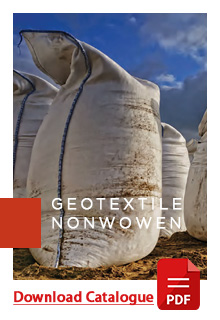They are typically made from polypropylene or polyester. In many cases, geotextiles replace or reduce the need to use natural aggregate construction materials which provide both economic and environmental benefits. We offer a range of geotextiles including nonwoven and composites.
Our Nonwoven Geotextiles are made from polypropylene fibers that are needle-punched to form a dimensionally stable network and have a wide range of applications in civil environmental engineering and construction projects. the geotextile usages are:
- Filtration of soils in drainage applications by retaining soil particles while allowing for the free flow of water.
- Separation and stabilization in road and railway constructions.
- Prevention of soil movement in erosion control measures.
- Cushioning and protection in many containment projects.
- Our geotextiles are available in varying strengths and thicknesses to ensure appropriate material selection for the project requirements.
Related Article : Application of nonwoven geotextiles in improving asphalt and roads
Geotextile Applications
- Reinforcement
- Separation
- Drainage
- Filtration
- Containment
- Protection
- Erosion Control
Main Applications of Geotextile
- Road construction, highways.
- Embankments, Asphalt repaving of roads.
- Coastal & riverbank revetment systems.
- Filtration.
- Drainage.
- Composites.
- Protection for Geomembrane in landfills.
Related Article : applications geosynthetic
| Test | Test Method | Unit | M . A . R . V |
|---|---|---|---|
| Grab Strength | ASTM D – 4632 | N | 450 |
| Mass Per Unit Area | ASTM D – 3776 | g/m2 | 140 |
| Ultimate Elongation | ASTM D – 4632 | % | 50 |
| Asphalt Retention | Texas DOT Item 3099 | 1/m2 | 1.2 |
| Melting Point | ASTM D – 276 | Centigrades | 150o |




